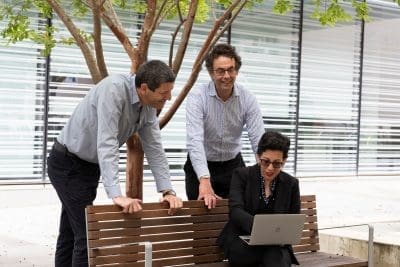Advanced Water Capture from the Atmosphere, University of Sydney
Published on by Water Network Research, Official research team of The Water Network in Academic
A UNIVERSITY of Sydney team has won a research challenge for its project working on passive collection systems designed to extract water out of thin air.

From right – Professor Chiara Neto, Professor Martijn de Sterke, Craig Shapiro. Photo Stefanie Zingsheim University of Sydney.
A Sydney Nano team, led by Professor Chiara Neto and Professor Martijn de Sterke, working on technology to accelerate condensation to turn water vapour into liquid water, will receive $25,000 to develop its Advanced Capture Water from the Atmosphere (ACWA) system, after winning Bridge Hub Water Challenge Australian Research Stream prize, sponsored by the CSIRO.
Once the ACWA prototypes are ready for commercialisation, the Sydney team will receive up to a further $100,000 from the Blue River Group.
ACWA team leader Professor Neto said it was fantastic to see the work of the ACWA team recognised by the Bridge Hub Water prize.
“The prize will give a great boost to our ambition to develop a sustainable technology that creates clean water where and when it’s needed.”
ACWA is a passive water extraction system, which means it is ideally suited to low-maintenance, low-managed systems. It also has no moving parts, requires no energy inputs and can operate 24 hours a day, making it potentially ideal for the agriculture sector to supplement and support irrigation and feed systems.
Nano-engineered surfaces
It does this by using nano-engineered surfaces that mimic natural hydrophobic (water repellent) surfaces, such as those of beetles, to accelerate condensation, turning water vapour into liquid water.
The system will rely on converting large, unused surfaces into passive water extraction ‘factories’, which will extract about a litre of water a day per square metre.
“Water is a precious resource and in dry countries like Australia must be managed carefully. As water security becomes more uncertain due to climate change, this will become even more important,” Professor Neto said.
“Because of this scarcity, this also means water is big business. In Australia alone the water entitlements market is worth more than $22 billion a year.”
Sydney Nano Director Professor Benjamin Eggleton said: “We are enormously proud of Chiara, Martijn and the ACWA team.
“This is a flagship for the University of Sydney Nano Institute – one of our Grand Challenge projects. ACWA embodies the best of multidisciplinary and mission-directed research with a focus on real-world impact, underpinned by leading-edge nanoscience and nanotechnology.”
The next steps for ACWA include further development and design of working prototypes, testing and maximising surface efficiency, securing a manufacturer and moving to pre-market testing.
As well as Professor Neto’s expertise in surface chemistry and Professor de Sterke’s in electromagnetism, the team is harnessing skills from a wide range of researchers, including PhD candidate Ming Chiu, who is a paint chemistry expert and Dr Karla Straker, a design expert in the School of Architecture, Design and Planning.
Bridge Hub Water Challenge
Launched in February, the Bridge Hub 2020 Water Challenge aimed to uncover the best research, the most innovative ideas, and the best startups that positively impact water sustainability across our agrisystem. The global challenge attracted more than 150 researchers and entrepreneurs from Australia, New Zealand and Israel.
The ACWA team has been named the winner from more than 100 applicants and selected from eight finalists in the Australian research stream, beating teams from UNSW, Murdoch University, ANU and UTS.
Craig Shapiro, CEO of Bridge Hub, said: “The quality of not only the winning solutions but of all the applicants highlight that we have the capacity to achieve anything if we turn our minds to the task at hand. Our ability to solve problems across the entire agrifood supply chain is only limited by our imagination.”
Attached link
http://www.youtube.com/embed/D3GdrifXhJ8Taxonomy
- Water from Air